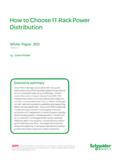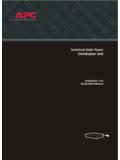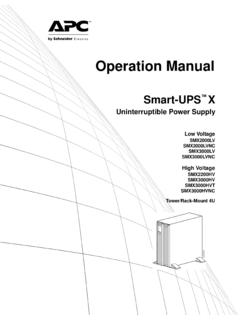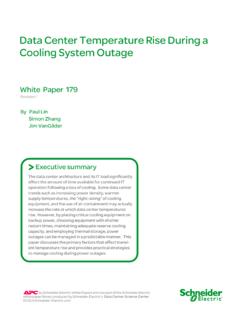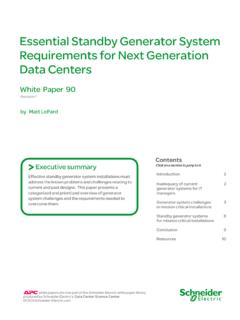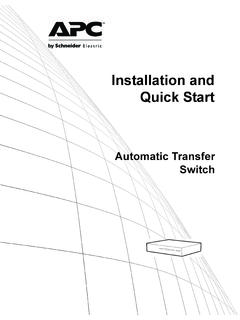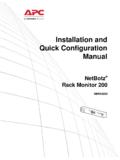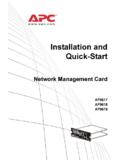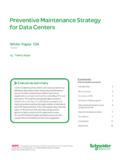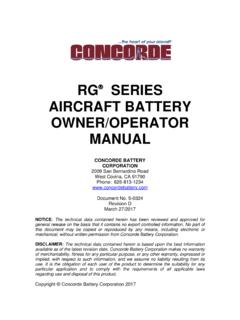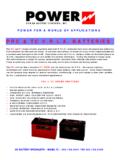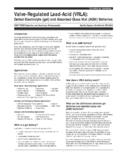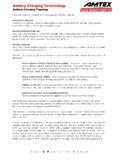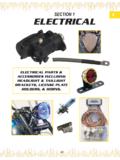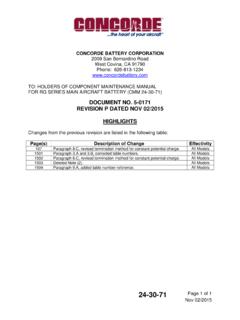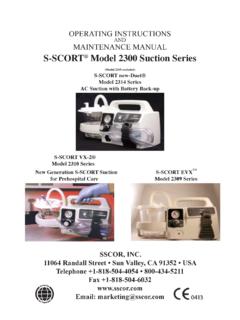Transcription of Battery Technology for - - APC USA
1 Battery Technology for Data Centers and Network Rooms: Ventilation of Lead-Acid Batteries Introduction 2 Terminology 2 Environmental design considerations 4 Conclusion 7 Resources 8 Lead-acid batteries are the most widely used method of energy reserve. Ventilation systems must address health and safety as well as performance of the Battery and other equipment in a room. Valve regulated lead acid (VRLA) batteries and modular Battery cartridges (MBC) do not require special Battery rooms and are suitable for use in an office environment.
2 Air changes designed for human occupancy normally exceed the requirements for VRLA and MBC ventilation. Vented (flooded) batteries, which release hydrogen gas continuously, require a dedicated Battery room with ventilation separate from the rest of the building. This paper summarizes some of the factors and codes to consider when selecting and sizing a ventilation system for a facility in which stationary batteries are installed. Executive summary> Revision 3 by Stephen McCluer White Paper 34 Click on a section to jump to it Contents by Schneider Electric White Papers are now part of the Schneider Electric white paper library produced by Schneider Electric s Data Center Science Center Battery Technology for Data Centers and Network Rooms: Ventilation of Lead-Acid Batteries Schneider Electric Data Center Science Center White Paper 34 Rev 3 2 The main objectives of any ventilation system are management of environmental air tempera-ture, humidity and air quality.
3 In a data center, or any facility in which electrical equipment and Battery systems are installed, the ventilation system must address: Health safety - the air must be free of pollutants that could be toxic, corrosive, poison-ous, or carcinogenic Fire safety - the system must prevent and safely remove the accumulation of gasses or aerosols that could be flammable or explosive. Equipment reliability and safety - the system must provide an environment that optimiz-es the performance of equipment (including both batteries and electronic equipment) and maximizes their life expectancy Human comfort Stationary lead-acid batteries are the most widely used method of energy storage for information Technology rooms (data centers, network rooms). Selecting and sizing ventilation for Battery systems must balance and trade off many variables.
4 These could include different Battery technologies, installation methods, operating modes, and failure modes. Battery technologies are described in detail in other white papers (see the Resources and References section at the end of this paper). The following brief overview describes different lead-acid Battery technologies and how they would interact with a ventilation system. Battery types Vented lead acid batteries are commonly called flooded or wet cell batteries be-cause of their conspicuous use of liquid electrolyte. As the name implies, this type of Battery vents hydrogen continuously during normal float operation. The electrolyte is sulfuric acid diluted in water. Vented batteries are usually installed on open racks in dedicated Battery rooms that have dedicated ventilation systems to prevent mixing with ventilation systems for the rest of the building Valve regulated lead acid (VRLA) batteries are the most widely used Battery type because of their high power density and ease of use.
5 VRLA batteries are considered to be sealed because they normally do not allow for the addition or loss of liquid. A vented Battery can give off sixty times more gas than a VRLA Battery in normal use. The term VRLA derives from the use of safety valves that allow pressure to be released when a fault condition causes internal gas to build up faster than it can be recombined. VRLA batteries can be mounted on open racks (rarely), or in cabinets (most common). Small power systems (such as single-phase UPS systems) integrate VRLA batteries inside their own enclosures. VRLA batteries can use the ventilation provided for hu-man occupancy. Modular Battery cartridges (MBC) are actually strings of VRLA batteries packaged into cartridges that can be swiftly plugged into a power system that has the appropriate mating connections.
6 MBCs are designed for use in a data center, network room or of-fice environment and can use the ventilation provided for human occupancy. Modes of operation All Battery types work on the principle of chemical reactions between positive and negative plates. Because they have different technologies, they have different considerations for ventilation under the same operating mode. Introduction Terminology Battery Technology for Data Centers and Network Rooms: Ventilation of Lead-Acid Batteries Schneider Electric Data Center Science Center White Paper 34 Rev 3 3 Storage stored lead-acid batteries create no heat. High ambient temperatures will shorten the storage life of all lead-acid batteries. o Vented (flooded) Vented Battery units would normally be stored with ship-ping plugs installed, in which case they release no gas.
7 With shipping plugs removed, vented Battery units can give off minor amounts of hydrogen and oxygen due to normal evaporation of water (depending upon the amount of ambient heat and air humidity).. o VLRA and MBC create no off-gassing unless stored in extreme heat Normal mode in back-up applications the batteries are kept at a constant state of maximum potential (called float voltage) in order to ensure maximum power reserve. The constant presence of voltage causes batteries to continuously create hydrogen and oxygen. Optimum ambient temperature is defined by the Battery manufacturer, but usually ranges from 20 C to 25 C (68-77 F). Higher room temperatures increase off gassing and shorten Battery life. When float charged at the manufacturer s recom-mended voltage and room temperature, a Battery can generate heat roughly in the magnitude of of the full load operating power of the batteries.
8 O Vented (flooded) some of the hydrogen gas is released into the room. Flooded lead acid batteries can vent approximately 60 times more hydrogen than comparably rated VRLA batteries. o VRLA and MBC hydrogen recombines under pressure with oxygen into water inside the Battery . Gas can only escape when internal pressure ex-ceeds the rating of the pressure valve. Discharge batteries vent little or no gas during a discharge. High ambient tempera-ture will cause more chemical reaction and longer run times, whereas low ambient temperature does the opposite. The Battery generates little heat. However, the power electronics supported by the Battery might run slightly hotter during a discharge. o Vented (flooded) little or no gas vented during discharge.
9 O VRLA and MBC little or no gas vented during discharge. Recharge higher charging voltage following a discharge causes the Battery to heat up and release some measure of hydrogen gas. More voltage means more gas re-lease. o Vented (flooded) release the most hydrogen into a room during recharge. o VRLA and MBC release little or no gas until the Battery is recharged to approximately 80% of its capacity. VRLA is vulnerable to overheating if voltage and/or ambient temperature exceed recommended levels, so nor-mal charging regimen of any UPS is to reduce the charging rate during the last 20% of its charging. Failure mode a rare but serious Battery failure mechanism in lead acid batteries is a condition known as thermal runaway. Thermal runaway is preventable.
10 O Vented (flooded) flooded batteries are largely immune to thermal run-away, but it is not impossible. o VRLA and MBC only a tiny percentage of VRLA Battery systems ever ex-perience thermal runaway. It is most likely to occur on inexpensive systems without appropriate protective circuits. This condition can be triggered by a cell failure, improper float voltage settings, charger failure, high ambient temperature around the batteries, excess charger capacity, or a combina-tion of these conditions. Charger over-voltage is the most common cause. In thermal runaway heat generates inside the Battery faster than it can be dissipated. The safety valves open and the Battery vents hydrogen until temperature and/or voltage are reduced, or else the Battery melts or dries out.
